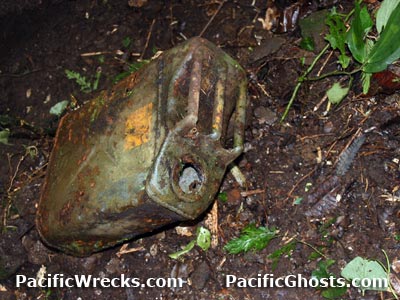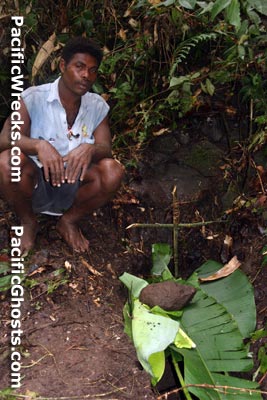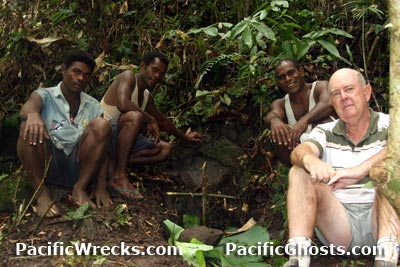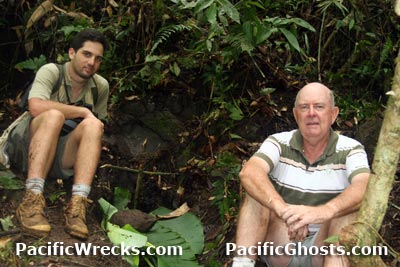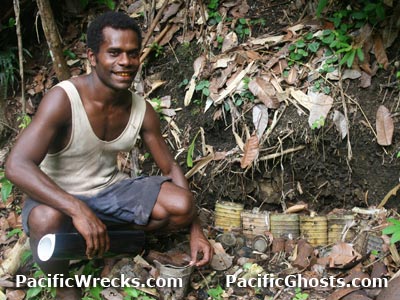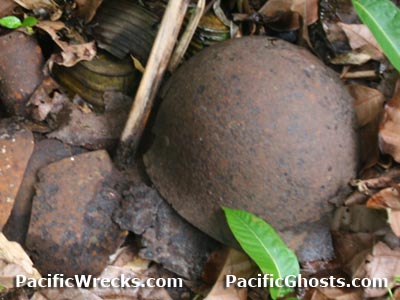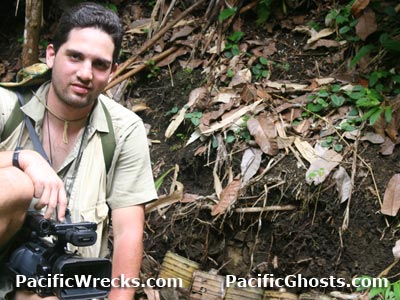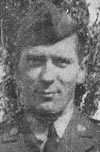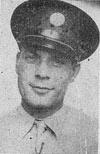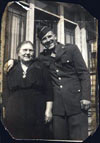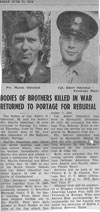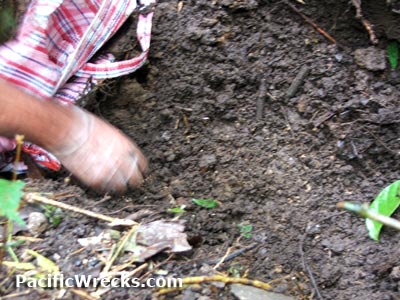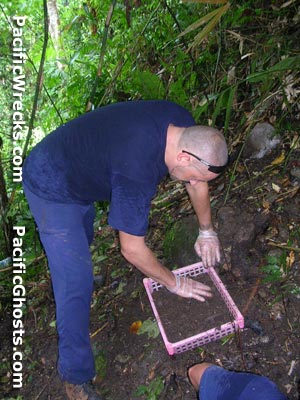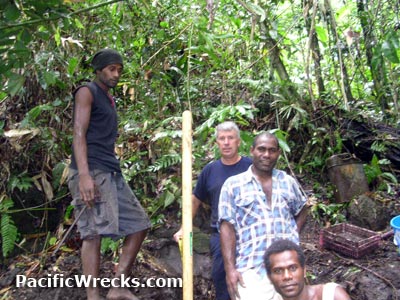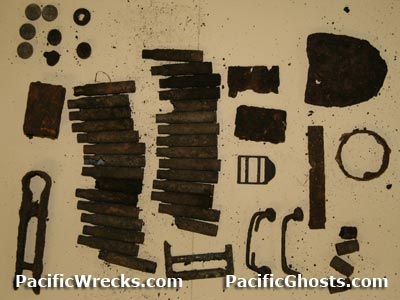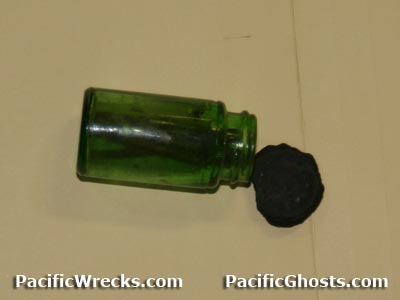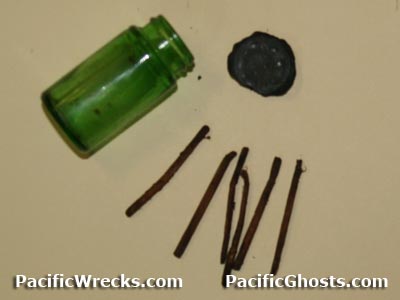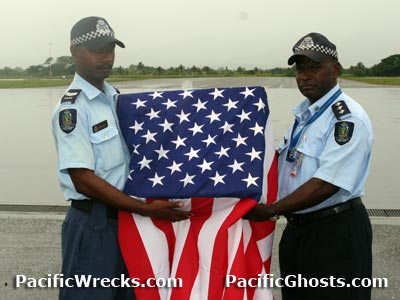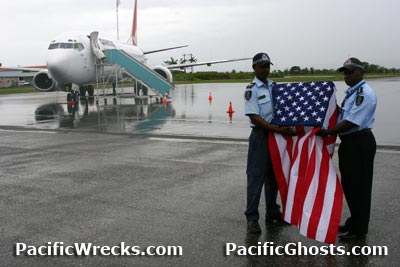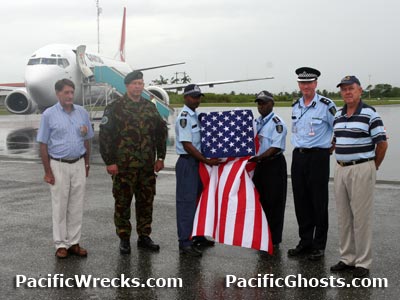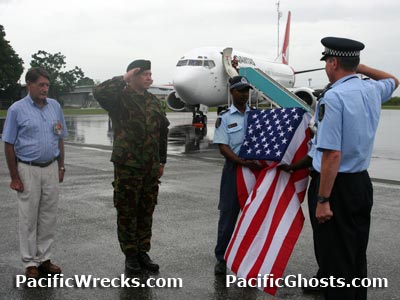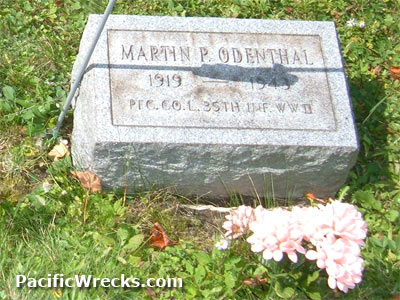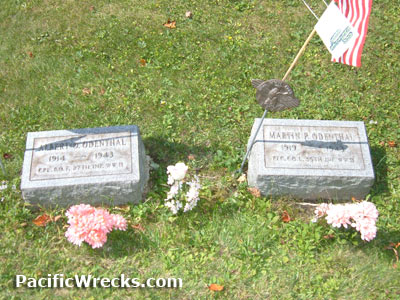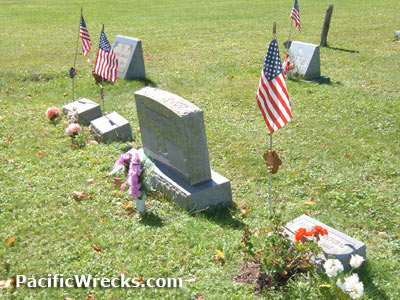Private Martin P. Odenthal
25th Infantry Division "Tropic Lightning", 35th Infantry Regiment "Cacti"
Dog Tag and Grave Discovery on Guadalcanal
by Justin Taylan
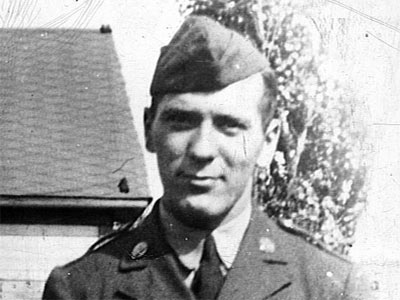 |
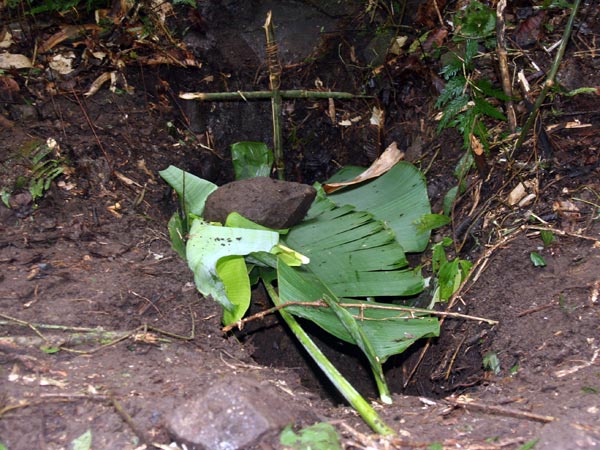 |
| Private Martin Odenthal |
Grave of Private Marin Odenthal KIA January 10, 1943
Body Not Recovered until January 2006 |
A Jungle Discovery
During January 2006, Solomon Islander Peter Bessi visited John Innes and I. Peter lives in a village that John visits weekly on his tours, and the two have been friends for years. While trekking in the jungle near the Sea Horse Battlefield, he located the previously unknown field burial of an American soldier, with his dog tag. Leaving the site undisturbed, Peter made the long trek back into town, to report the find to us. Peter recorded the name on the dog tag as proof: "Martin P. Odenthal". Researching online, the name was confirmed as a Private Killed in Action (KIA) on January 10, 1943. This name was an authentic Guadalcanal casualty. Immediately, we planed to meet Peter at his village and trek to the remains the very next day.
Trek To Sea Horse Battlefield
John Innes and I departed early the next morning. We picked up Peter and drove as far as possible on an overgrown logging road that wound along jungle ridges. Our destination was an area near two grass covered hills that jutted above the otherwise unbroken jungle canopy. The US Army coded them simply: Hill 43 and Hill 44. From the air, with a vivid imagination, these two hills are shaped like a 'Sea Horse', hence the nickname. Sixty four years ago, in January 1943, this area was a battlefield.
The 'Sea Horse' was then defended by the remaining elements of the Japanese Army. Although defeated in their counter attacks against the American perimeter, they were now entrenched in these inland hills and ready to fight to the death. Tasked with eliminating them was the U.S. Army 25th Infantry Division "Tropic Lightning", which landed in December 1942 to relieve the 1st Marine Division. The Marines had been fighting on Guadalcanal since their landing on August 7, 1942.
When our vehicle nearly bogged down in mud, we proceeded on foot. Sixty years ago, there was no logging road here, only virgin jungle. From January 8-9, 1943, the US Army's 35th Infantry Regiment, nicknamed "Cacti" made the same trek. Without the benefit of any trail as they moved towards "Sea Horse", they had to cut a path with machetes and their bayonets.
Although the 'Sea Horse' battle remains largely unknown to today, another nearby series of hills known as 'Galloping Horse', were the fictionalized subject of the James Jones novel, The Thin Red Line and the 1999 Hollywood film by the same name. The logging road deteriorated into a small foot paths that only to our guides could locate. We followed our guides Peter and Sam back to the area where they had made the discovery. Amazingly, they were both barefoot and had hardly broken a sweat. Without their help, we would never have found anything.
We were far from any village or road. Few come here, aside from the occasional villager like Peter. We descended down a steep slope, where it was difficult to even stand up. It was hard to imagine making this trek carrying a heavy pack and rifle. Huge trees covered in vines and leaves were all around us, blocking forward visibility and choking out any direct sunlight. This vast jungle could hide anything.
These same ridges we were walking, were once the site of violence and heroism, that claimed the lives of many Americans and Japanese. On January 10, 1943 in the morning, the Japanese attacked the advancing Americans from L and M Companies of the 3rd Battalion, 35th Infantry Regiment. They pinned down the American riflemen, and disabled their two supporting machine guns by killing one machine gunner and wounded the assistant for the second. The Americans begin returning firing, but many fell wounded and killed.
The casualties would have been worse, had it not been for the heroism of Lewis Hall and William Fournier who ran forward to operate the empty machine gun. Fournier lifted it by its tripod to depress the barrel in order for Hall to aim and fire. They continued firing until both were fatally wounded. Both men posthumously earned the Medal of Honor. [ List of US Army KIA on January 10, 1943 ]
During the fierce fighting, Odenthal was one of those killed in action. His comrades quickly buried him where he fell. One of his dog tags was taken for Grave Registration, and the other left on his body. The men then continued their mission to capture Sea Horse. After the battle, Grave Registration never located his grave, making his status in Army parlance: Killed in Action, Body Not Recovered (KIA / BNR).
Today the sounds of war are gone, replaced by the shrill cry of tropical birds and chirps from insects. Now, it was difficult to see anything aside from green foliage, trees and vines around us. Although the jungle has reclaimed most of obvious signs of warfare, I noticed some expended shell casings on the ground between my feet.
Martin Odenthal's Grave Site
Descending a steep ridge, we finally reached the grave. The grave was marked with a 'jerry can' used to carry water, likely left by Martin's buddies to clearly mark the location. Underneath was a shallow grave, rusted buttons and expended shell casings were also visible. Certainly, this soldier had died fighting. One object clearly visible was an untarnished dog tag. The embossed lettering read: MARTIN P. ODENTHAL.
Marin Odenthal finally had company at his lost grave site. John verbalized what we were all feeling, saying aloud: "Hello Martin! We are here." From then on, we referred to the remains as "Martin". I carefully documented the site with photos and video. Sam used his bush knife to carve a simple cross and used a vine to attach the cross pieces. Satisfied, we took a GPS coordinate and posed for photos at the simple jungle memorial to this fallen US Army Private who died sixty-four years ago.
Before departing, our guides took me over the next ridge. Although my GPS indicated we had moved only a few hundred meters forward, it took nearly an hour to get there. This ridge was littered with Japanese remains. Among the remains of one individual, was a live grenade and a spool of communication wire. Elsewhere were helmets and gas masks. The Japanese Ministry of Health Labor and Welfare, tasked with veteran affairs would be interested in these remains too. I noted each separate set of remains and as the afternoon drew to a close, we started our long trek home. These hills were the graves of many more than just Martin.
Contacting the Odenthal Family
Back at John's office, research continued. The dog tag listed Martin's hometown and his surname was not common. I suggested we do an Internet white page search, and amazingly found several "Odenthal" names listed. John picked up the phone and called. On the first try, we had found Ralph Odenthal, Martin's youngest brother! Another call found Martin's niece, Lisa. After their initial surprise about our call from overseas, both were full of emotion. When John asked “What do do you want done with the remains?” Their response was a firm: “We want him home!”
Martin Odenthal & His Brothers
Martin Odenthal was born on March 25, 1919 in Springhill, Pennsylvania. He grew up in Portage, Pennsylvania and attended Portage Township Schools and had a job working for Johnstown Coal & Coke Company. On June 13, 1940, Martin Odenthal and his brother Albert Odenthal (born December 30, 1914) joined the US Army at Johnstown, Pennsylvania. Their oldest brother, Peter W. Odenthal (born 1913) and youngest brother, Ralph (born 1923) joined the United States Navy.
Martin and Albert were were both assigned to the 25th Infantry Division "Tropical Lightning" based at Schofield Barracks. Private Martin P. Odenthal, 7025610 was assigned to the 35th Infantry Regiment "The Cacti", 3rd Battalion, L Company. Corporal Albert O. Odenthal, 7025607 to the 27th Infantry Regiment "Wolfhounds", Company F.
On December 7, 1941 the brothers witnessed the surprise Japanese attack on Pearl Harbor and Oahu. Immediately, the Division was put into action to defend the island's beaches against the threat of an invasion before being shipped overseas to fight against the Japanese on Guadalcanal.
Martin and Albert were both were Killed In Action (KIA): Martin died on January 10, 1943. His brother, Corporal Albert O. Odenthal, was Killed in Action on August 12, 1943 in the vicinity of Munda on New Georgia. Albert's body was recovered and postwar his remains were transported to his hometown for internment on June 27, 1948.
Ralph was a veteran of the US Navy who participated in the June 6, 1944 D-Day invasion of Omaha Beach at Normandy, France. His Naval career was cut short, when he was ordered to depart from his ship because his two brothers had been killed and was ordered home and given an honorable discharge, just like the storyline portrayed in the Hollywood movie Saving Private Ryan.
Recovery of Remains
As per the Odenthal families wishes, John contacted Joint POW / MIA Accounting Command (JPAC). JPAC said they were unable to dispatch a team to recover the bones, but . Instead they provided paperwork to fill out and requested were collect the remains and send them to their laboratory in Hawaii. The Japanese embassy was not interested in the bones found at Sea Horse. They remain where we found them.
Members of the New Zealand Police temporarily based on Guadalcanal to assist the Solomon Islands volunteered to undertake the recovery. Sam and Peter guided them back to the grave. The Police officers included Inspector Chris Douglas, Detective Tony White, Constable Chris Todd. Before undertaking the recovery, the Police offered a "karakia", a Maori prayer paying respect to a spiritual presence: "Tena koutou i o tatou tini mate haere, haere, haere. (We acknowledge our many dead, farewell, farewell, farewell).
As dirt was carefully sifted, remains were separated from personal effects, including thirty-five spent M1 rifle cartridges. The only object of a personal nature was a small green bottle with a rubber stopper. Inside were six matches. These are to be returned to the Odenthal family.
Departure Ceremony
The next challenge was how exactly to send his remains to JPAC in Hawaii. Couriers like FedEx and Airborne Express refused to ship human remains. An Air Fiji pilot agreed to carry the boxed remains from Guadalcanal via Fiji to Hawaii where it was hand delivered to a JPAC representative.
Before boarding the flight, a memorial ceremony was led by John Innes. Present were the New Zealand Police Officers, Solomon Island representatives, veterans and the general public. It seemed everyone on Guadalcanal knew about "Martin", a young soldier who had waited so long. Now, he was finally going home. A chain of good will carried Martin's remains from the jungle back to American soil. The remains were received by JPAC on February 21, 2006.
DNA Testing
Almost a year later on February 26, 2007, Major Paul Madrid contacted relatives from the Odenthal family, seeking Family Reference Samples (FRS), a blood sample to do a mitochondrial DNA (mtDNA) test against the remains from Guadalcanal, to prove a match. Testing requires someone on the mother's side of the family, and his sister Ida (Odenthal) Pauley's daughter Shirley Hazlett agreed to provide the sample.
On July 10, 2007 the results of the DNA test proved what everyone already knew: the remains were indeed Martin P. Odenthal. The family were not officially notified by the by the military until months later.
Sadly. his brother Ralph passed away on September 17, 2006 without knowing the results of the test or about the positive identification of Martin's remains. Himself a veteran, Ralph was buried in Prospect Cemetery opposite his parents with full military honors.
Odenthal Family Graves at Prospect Cemetery
On June 24, 1948, the bodies of brothers Cpl. Albert O. Odental and Pfc Martin Odenthal were returned to Portage for reburial. On June 27, 1948 funeral services were held at Trinity E. U. B. Church with burial at Prospect Cemetery in Portage, Pennsylvania. Next to his marker, is the grave of his brother Albert who was also killed in the Solomon Islands. When their parents died, each was laid to rest beside their beloved sons. Father William J. Odenthal died December 10, 1949 and his wife Ida (Brunett) Odenthal died February 10, 1960.
During 2007, the remains recovered from Guadalcanal were buried at Jefferson Memorial Park at
section G27 pine lawn lot 591.
References
Farewell to a Warrior by John Innes
News
"Bodies of brothers killed in war returned to Portage for reburial" June 25, 1948
35th Infantry "The Cacti" (35th Infantry Regiment Association)
National World War II Memorial - Albert Odenthal (Thomas J. Bradley, Cousin / Ralph Odenthal / N. & J. Fawcett)
National World War II Memorial - Ralph Odenthal (Lisa Odenthal Dividock)
National World War II Memorial - Martin Odenthal (Ralph Odenthal / Norman & Joanne Fawcett)
NARA "WWII Honor List of Dead and Missing Army and Army Air Forces Personnel" / Cambria County, page 35
FindAGrave - Pvt Martin P. Odenthal (Portage Cemetery)
FindAGrave - Martin P. Odenthal (Jefferson Memorial Park Cemetery)
FindAGrave - Cpl Albert O. Odenthal (brother)
FindAGrave - Ralph Cloyd Odenthal (brother)
FindAGrave - Peter W. Odenthal (brother)
FindAGrave - William J. Odenthal (father)
FindAGrave - Ida (Brunett) Odenthal (mother)
Thanks to John Innes, Peter Bessi, NZ Police Sgt. Gene Smith, Peter Odenthal, Rachael Phillips and Johnie Webb
Contribute
Information
Do you have photos or additional information to add?
|



